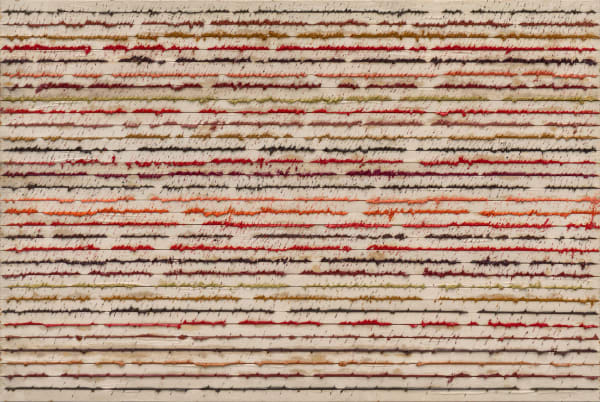-

-
Exhibition Walkthrough Video
Narrated by John Yau
Video Edited by Hyunjung Rhee
-
Presenting the full breadth of his materials, methods, and creative experimentation
Predominantly known for his Dansaekhwa paintings, Ha Chong-Hyun (b. 1935) has tirelessly devoted his long career to exploring and understanding materials and their properties. Trained as a painter and quickly emerging as a leading artist during the period of postwar reconstruction in Korea, Ha began his career by developing his own artistic vocabulary beyond the bounds of painting, reflecting his broad interests in the contemporary social milieu. After graduating from Hongik University in 1959, he produced abstract works which were linked to the then prevalent Korean Informel movement, but his distinctive use of dark tones, created by burning the canvas surface with fire, distinguished Ha's works from the mainstream. The powerful and unique results of this process evoked a powerful balance of aesthetic refinement and the somber spirit of the time, an era still shadowed by the traumas of war.
-
Gallery 1 - Conjunction series (1980s-2000s)
The year 1974 saw the birth of the Conjunction series, which would make him a leading figure of Dansaekhwa, as he began pushing oil paint through the weave of the fabric support from the back to the front known as bae-ap-bup (背壓法).
While white paint was mostly dominant in his early Conjunction series, the artist expanded his palette in the 1990s to include ochres, dark greens, and blacks. Featuring a selection of white and black Conjunction paintings, the following gallery displays variations of the series demonstrating the artist’s endless creative experimentation. Brushing over the canvas surface after pressing paint from the back, Ha created countless different textures and trace gestures on the variegated surfaces. As such, all works from the 1980s up until now reveal the slow progression of his Conjunction series.
-
Gallery 2 – Naissance and White Paper on Urban Planning (1960s)
After Ha’s participation in the Biennale de Paris of 1965, he actively sought new methods and techniques, expanding his approaches to experimenting with the two-dimensionality of painting. Produced between 1967 and 1968, two new series, Naissance and White Paper on Urban Planning, show how the artist had developed his own geometric abstraction, drawing inspiration from Korean traditional arts and crafts and irregular patterns found in urban landscapes.
The Naissance series capture Ha’s interest in the tension between geometric and organic forms as well as between two- and three-dimensionality, while the White Paper on Urban Planning series recall the newly constructed highways and beltways that were crisscrossing postwar Korea. These symbolic gestures coincided with Korea’s rapid transformation from a war-torn country into an urban, industrialized one.
-
Gallery 3 – Wire works and 1970s works
Between 1969 and 1973, as a founder and active member of the avant-garde artist collective known as AG (Avant Garde Association), Ha experimented with space by producing site-specific installations and three-dimensional works with quotidian objects, such as barbed wire, plaster, timber, metal springs, and newspaper. By engaging with such diverse methods and materials, Ha escaped the two-dimensional bounds of painting.
Of the diverse objects that Ha has worked with, barbed wire was of particular interest to the artist. In the early 1970s, the artist produced a series of works by attaching barbed wire and wire springs to fabric supports, thus transforming and transgressing the supports’ two-dimensional surfaces and structures. In a country that had experienced colonization, war, and physical division all within just fifty years, barbed wire quickly become a mundane, ubiquitous material in the landscape. By appropriating it, Ha transformed it into a powerful expression.
This section also includes Ha’s works linked to the Korean Informel movement that garnered critical prominence. In Work C (1962), for example, Ha created complex patterns by charring the painted canvas surface with fire. Whether using new materials like wire, or more unusual methods such as his use of fire or bae-ap-bub in his Conjunction series, all of Ha’s works demonstrate his curiosity and the lengths he was willing to go to challenge established conventions.
-
Gallery 4 – Post-Conjunction series
Ha’s Post Conjunction works between 2010 and 2012 were produced by pressing paint between wooden shimswrapped in canvas and placed on the surface, a technique that causes the wet paint to be pushed through the gap. In the Post Conjunction series, the artist varied his colors and material properties. Not only did he use white in addition to various colors of paint for pressing, but the support could also be prepared unpainted or painted in color prior to the process. Ha also began composing using mirrored panels on the canvas so that the complex surfaces reflect the audience and their environment. In addition, he began to utilize collage on the surface after pressing paint from the reverse side. In this way, within the parameters of the series, Ha has deployed a vast array of techniques exploring the support itself, the surface, and the physical properties of materials, including paint, gravity, and gesture.
-
Gallery 5 – New Conjunction series (Present)
This section presents selections from Ha’s new works produced since 2020. Ha produced these paintings by pressing white paint through the weave of the fabric support painted in black, and he then further worked on the surface with black or other single colors. Conjunction 22-01 (2022), for example, shows blue paint over the white paint pressed from the back, conjuring an image of sky. Ha’s works capture something beyond ink-and-wash watercolors; produced through an intensive layering process and exploration of his chosen materials, these works embody the artist’s deep deliberation on the physical and aesthetic properties of paint and time.
-

-

Exterior of Palazzetto Tito. Photo: Giorgio Bombieri
-
Location
Palazzetto Tito
2826 Dorsoduro
30123 VeniceOpening Hours: Daily, 10:30 AM – 5:30 PM
Ha Chong-Hyun : Collateral Event of the Biennale Arte 2022
Past viewing_room





















